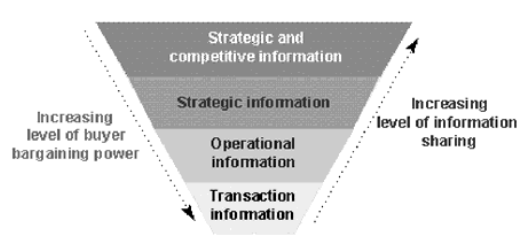The diversity of information content and the numerous sharing options makes it seemingly impossible to classify the nature or level of information sharing. Our field studies have indicated that a number of different sharing arrangements are possible. For example, some suppliers share inventory position information of the products a certain supplier sells them. This information may be transmitted daily, or weekly; the level of detail also varies. There are suppliers who see the store-level day- to-day point-of-sales (POS) information; there is a great deal of variety here as well – some see only product UPC’s and quantities, while others have access to temporal sales distribution and customer profiles. Other buyers transmit order quantity, payment and cost information using EDI – this is a situation where the volume of information exchanged may be great, but its impact on the operations of the firms is relatively low.
If one examines information from another perspective, the problem simplifies a great deal. Treat the level of information shared not based on what its exact content or volume is, but rather, based on the impact it has on the operations, sales, marketing and production strategies of the parties that contract to share the information. Using this view, one can classify IOIS arrangements into four categories, based on the level of impact the shared information has on the buyer and supplier (Figure 1)

Figure 1: Models of information sharing
The first level involves increased cost-and-time-effective exchange of transaction-level information (like order quantities and prices) through EDI. The second level involves sharing select operational information (such as inventory levels) in order to exploit superior expertise across organizational boundaries, and improve operating efficiency. At the third level, the information shared has strategic value to the party that receives the information. Finally, at the highest level, the information adds both strategic and competitive value to the party that receives it.

